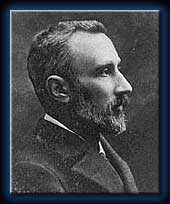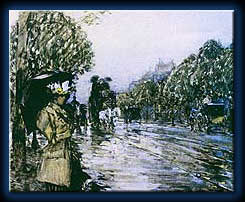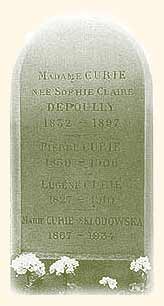|

|
| A few days before his death, Pierre was cautiously
optimistic about the progress he and Marie were making in their
attempt to make precise measurements of the radioactive gas
that radium emitted. He also thought of returning to the studies
of crystal symmetries he had set aside when their joint work
began. (Photo ACJC) |
|

 A Fatal Accident
A Fatal Accident
 IFE
WAS SEEMING A BIT ROSIER to Pierre Curie in the spring of 1906.
During the family's recent Easter holiday in the country, he had
enjoyed watching the efforts of 8-year-old Irène to net butterflies
and of 14-month-old Eve to keep her footing on the uneven turf.
More crucially, perhaps, Pierre had become involved in his work
again. IFE
WAS SEEMING A BIT ROSIER to Pierre Curie in the spring of 1906.
During the family's recent Easter holiday in the country, he had
enjoyed watching the efforts of 8-year-old Irène to net butterflies
and of 14-month-old Eve to keep her footing on the uneven turf.
More crucially, perhaps, Pierre had become involved in his work
again.
Pierre Curie's agenda
for Thursday, April 19, 1906, was that of a man fully engaged in both
professional and social life. After a luncheon of the Association
of Professors of the Science Faculties, he was scheduled to go over
proofs with his publisher and to visit a nearby library. He was looking
forward to entertaining a number of fellow scientists at the Curie
home that evening. |
|
 IERRE
CURIE WAS NOT FATED to complete that day's activities. After
working in the laboratory all morning, he braved the heavy rain,
umbrella in hand, and traveled across Paris to his luncheon meeting.
There he spoke forcefully on a number of issues that concerned him,
including widening career options for junior faculty and drafting
legal codes to help prevent laboratory accidents. IERRE
CURIE WAS NOT FATED to complete that day's activities. After
working in the laboratory all morning, he braved the heavy rain,
umbrella in hand, and traveled across Paris to his luncheon meeting.
There he spoke forcefully on a number of issues that concerned him,
including widening career options for junior faculty and drafting
legal codes to help prevent laboratory accidents.
After the meeting
was over he headed out toward his publisher in the rain, only to
find that the doors were locked because of a strike. Hurrying to
cross the street, he was run over by a horse-drawn wagon with a
load of military uniforms, weighing some six tons. He was killed
instantly.
|
 |
| When Pierre's father learned that his son
had been killed crossing a Paris street in traffic on a rainy
day, he said, “What was he dreaming of this time?”
(Painting by Childe Hassam, 1893) |
|
|
“He
wasn't careful enough when he was walking in the street, or
when he rode his bicycle. He was thinking of other things.”
--Pierre Clerc, the Sorbonne lab assistant who identified
Curie's body
|
|
 ARIE
DID NOT LEARN the news that would transform her life until that
evening. In shock, she began to attend to the necessary arrangements.
She sent Irène next door to spend a few days with the neighbors, telegrammed
the news to her family in Poland, and arranged to have the body brought
to the house. Only after Pierre's older brother, Jacques, arrived
the next day from Montpellier did she break down briefly. The news
of Pierre Curie's death was carried in newspapers around the world,
and Marie was inundated by letters and telegrams. ARIE
DID NOT LEARN the news that would transform her life until that
evening. In shock, she began to attend to the necessary arrangements.
She sent Irène next door to spend a few days with the neighbors, telegrammed
the news to her family in Poland, and arranged to have the body brought
to the house. Only after Pierre's older brother, Jacques, arrived
the next day from Montpellier did she break down briefly. The news
of Pierre Curie's death was carried in newspapers around the world,
and Marie was inundated by letters and telegrams.
The day after the
funeral was notable for two reasons. Encouraged by Jacques, Marie
returned to her work. Also, Jacques informed Marie that the French
government proposed to support her and the children with a state
pension. Marie was adamant in her refusal, insisting that
she was perfectly capable of supporting herself and the children.
“Crushed
by the blow, I did not feel able to face the future. I could not
forget, however, what my husband used to say, that even deprived
of him, I ought to continue my work.”
If Marie was firm
in rejecting the government's offer of support, she was less certain
how to respond to an unexpected offer from the Sorbonne. On May
13, 1906, the university invited her to take up Pierre's academic
post. By doing so, she hoped, she could one day establish, as a
tribute to Pierre's memory, a state-of-the-art lab such as he had
never had. It was not enough to be a teacher and researcher. She
would have to learn how to create a scientific institution.
|
|
|
|
(above) Marie on the balcony of the Dluski
apartment on rue d'Allemagne, Paris. In the diary Marie began
11 days after Pierre's death, she described putting a copy
of this picture in Pierre's coffin: “it was the picture
of the one you chose as your companion....” (Photo ACJC)
READ
Curie's words
|
 |
| Curie family gravestone. Pierre was
buried with his mother in the Curie family plot in Sceaux,
on the outskirts of Paris, where eventually his father
and Marie joined them. Many years later Pierre and Marie
were reinterred in the Panthéon, the national sepulcher
for the most eminent French citizens. (Photo ACJC) |
|
|
© 2000 -
American Institute of Physics
|

